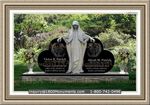|
What You Should Notice When Choosing Cemetery Plaques
There is healing process that many people go through following a death. Grief is a personal emotion and everyone deals with in their own way. For most, the cycle begins with the installation of a burial marker like gravestones or cemetery plaques at the location where the deceased is laid.
The main reason these markers are so useful in this process is that they make a situation that may seem unbelievable, more tangible. They not only give a bit of closure by marking the site where one's remains are laid to rest, but they also provide a lasting memorial to a loved one. Both of these purposes are necessary for a mourner to begin accepting the situation.
A monument of this type will forever let others know that a person worth remember once lived. The name of the one buried within the plot is emblazoned on the plaque, usually accompanied by their birth and death dates. Some people find it comforting to also add an epitaph, decorative designs or engravings.
These items are available in a wide range of shapes, styles and sizes. Many are made flat and even, though others will have text and features either carved into them or added in relief for more dimension. The level of conservativeness or ornateness is mainly dependent upon the desires of whoever makes the purchase decision.
Several different materials can be used for their construction. The most popular choice is bronze because of its durable properties, easy casting and beautiful appearance. Other substances such as stainless steel, brass, slate, granite and marble are also commonly used for this purpose.
While the wishes of the deceased or their surviving family members are important, there might be other factors to be considered when choosing a design. Some burial facilities may place restrictions on what styles and materials may be used. The climate could also affect the choices that are viable in a particular region.
|
|



























